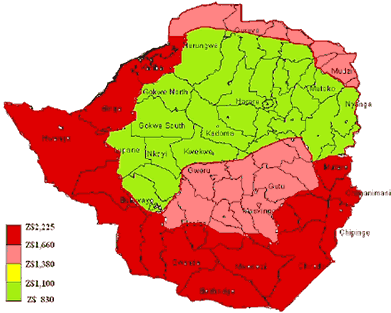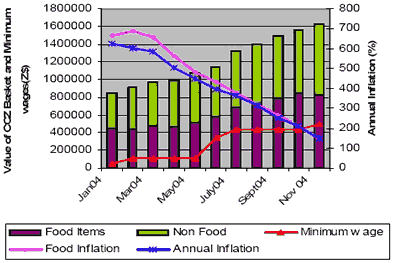|
Back to Index
Zimbabwe
food security update December 2004
Famine Early
Warning Systems Network (FEWSNET)
January 05, 2005
http://www.fews.net/centers/innerSections.aspx?f=zw&m=1001461&pageID=monthliesDoc
Summary and
implications
Staple
cereals are increasingly unavailable in most rural areas as the
peak hunger season progresses. Maize prices on the parallel markets
continue to rise, limiting the ability of deficit households to
buy enough food to satisfy their needs. High inflation and the Grain
Marketing Board (GMB) monopoly over marketing maize are exacerbating
the situation. In most urban centers staple cereals continue to
be available. But a smaller proportion of urban households are able
to purchase sufficient food due to the continued erosion of real
incomes. Food insecure households in both urban and rural areas
are responding through reducing their consumption. Over time, levels
of malnutrition and related diseases are expected to rise, peaking
in the January to March 2005 period.
Current
hazard summary
- Staple food
prices, already too high for the majority poor, are increasing
at very high rates; annual food inflation for November 2004 was
estimated by the Central Statistical Office (CSO) at 143.1 percent.
- Cereals are
not readily available in markets in grain deficit areas.
Food security
summary
Maize
prices on the parallel markets in both rural and urban areas went
up by over Z$200/kg between November and December this year. Urban
maize prices tend to be about Z$200/kg higher than in surplus rural
areas (the light green areas in Figure 1), but around Z$200/kg lower
than in deficit areas (the red areas in Figure 1). Maize availability
in the light green zone is still adequate. Deficit households in
this zone can obtain maize through purchase from local farmers (if
they have the money), direct labor exchange, or gifts/loans from
neighbors, friends and relatives from the same area. People going
hungry in this zone are predominantly the chronically poor who often
go hungry at this time even during normal years. The availability
of maize and staple grains in the two red zones has reached critical
levels and continues to worsen. Here, even people with some means
of earning money regularly are struggling to get maize on a regular
basis.
Figure
1 (Parallel Market Maize Grains Prices (Z$/kg) for Mid December
2004)

In the red and
pink zones, employment opportunities are few and incomes low, but
even people with means of earning income struggle to get maize on
a regular basis. The availability of grain depends on the erratic
and inadequate GMB supplies, which have been critically short and
continue to worsen. . Few households in these zones have the means
to travel into the other zones or to an urban market to buy the
maize they need. Consequently, they are forced to reduce the number
of meals, reduce the size of meals and/or spend the whole day without
having a meal at all. The GMB is having serious transport shortages
and are unable to adequately move the grain in some of its depots
and silos to the needy areas. Innovative humanitarian interventions
in this area could significantly address the food shortages faced
by many rural households.
The social protection
programs which were established to address the food needs of the
aged, orphans, chronically ill and other social welfare cases are
grossly inadequate. The targeted feeding programs currently allowed
by the government cannot adequately address the food insecurity
problem facing both urban and rural communities in Zimbabwe. The
humanitarian community in Zimbabwe needs to find fresh ideas, palatable
to both the Government of Zimbabwe and the donor community, to expand
the limited working space in which they are currently forced to
operate.
Urban
food security continues to be threatened by ever-rising cost of
living
The
cost of living in urban areas has increased steadily over 2004,
and the majority of urban households struggle to meet their basic
expenditure requirements. The cost of food and non food items has
increased 92 percent from January to November 2004, and wages and
salary increases have lagged. The November 2004 minimum industrial
wage of Z$500,000 could cover only 31 percent of the November 2004
CCZ expenditure basket. Although annual inflation has fallen to
149.3 percent, shedding 59.7 percentage points on the October 2004
rate of 209.0 percent, it still remains among the highest levels
of inflation in the world.
Figure
2: Cost of monthly expenditure basket for a low income urban household
of six in Harare, January 2004-November 2004

The cost of
the monthly basket for a low-income urban household of six, as monitored
by the Consumer Council of Zimbabwe (CCZ), stood at Z$1,630,755.
This marks an increase of 5 percent between October and November
2004. Much of this increase can be explained by increases in the
prices of sugar and fresh milk, 28 and 12 percent, respectively.
Other notable increases were recorded on non food items like accommodation,
which increased by 67 percent.
The
rainfall situation improves
The
rainfall situation improved significantly during the first two dekads
of December. At the beginning of December, the whole country, except
for the northeastern part, had received less than 75 percent of
normal rainfall (Figure3a). However, by December 22 the cumulative
seasonal rainfall over most of the country reached or exceeded normal
(Figure 3b). Totals exceeded normal over most of the northern half
of the country, while in the bulk of the south they reached at least
80 percent of normal. The improved rainfall situation is expected
to encourage farmers to prepare and plant more land.
Figure
3a: Percentage of normal rainfall as of 1 December 2004

Figure 3b:
Percentage of normal rainfall as of 22 December 2004

The government
reported that 977,694 hectares (ha) had been tilled and only 328,248
ha had been planted to crops by the end of November. Shortage of
tractors and low soil moisture were the major constraints. The area
reported to have been prepared is 41 percent of the average area
put to crops in the five seasons following the 1999/00 season. Considering
that most of this area was prepared in about one and a half months,
it is a conservative estimate to project that at least 2 million
hectares could be prepared by mid-January 2005 given the positive
rainfall forecast for much of the northern half of the country for
the second half of the rainfall season.
Armyworm
outbreaks in Masvingo, Midlands and Bulawayo
The government
department of Agricultural Research and Extension (AREX) reported
outbreaks of armyworm in parts of Matebeleland North, Midlands,
Masvingo and Mashonaland West Provinces.
Armyworm can
destroy large areas of crop and pasture in a short space of time
if not controlled. The pests are reported to be eating crops and
pasture. Up to 20 ha of crops are reported to have been destroyed
in Midlands Provinces alone and large tracks of grasslands have
been destroyed by the worm in and around Bulawayo. The impact of
the pest in other provinces is not yet clear. AREX is distributing
chemicals for controlling the pest and spraying has started.
Figure 4:
Districts Reporting Armyworm Outbreaks by 30 December 2004

Source: AREX
Please credit www.kubatana.net if you make use of material from this website.
This work is licensed under a Creative Commons License unless stated otherwise.
TOP
|

